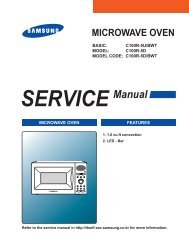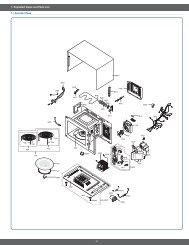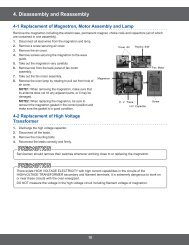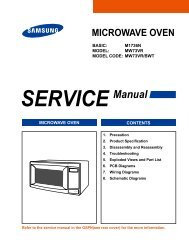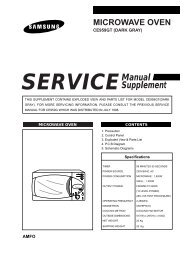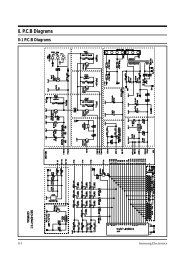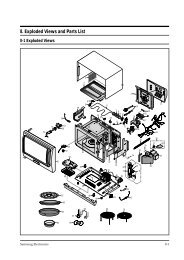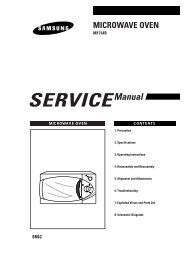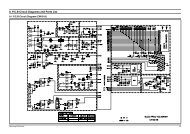microwave oven
microwave oven
microwave oven
You also want an ePaper? Increase the reach of your titles
YUMPU automatically turns print PDFs into web optimized ePapers that Google loves.
MICROWAVE OVEN<br />
M759R<br />
SERVICE Manual<br />
BWT<br />
MICROWAVE OVEN CONTENTS<br />
1 Min +<br />
Start<br />
10min /kg<br />
1. 2. 3.<br />
1. 2. 3.<br />
Auto<br />
1. 2. 3.<br />
1min/g<br />
10s. /<br />
Auto<br />
Auto<br />
1. Precaution<br />
2. Specifications<br />
3. Operating Instructions<br />
4. Disassembly and Reassembly<br />
5. Alignment and Adjustments<br />
6. Troubleshooting<br />
7. Exploded Views and Parts List<br />
8. PCB Diagrams<br />
9. Schematic Diagrams
PRECAUTIONS TO BE OBSERVED BEFORE AND DURING<br />
SERVICING TO AVOID POSSIBLE EXPOSURE TO EXCESSIVE<br />
MICROWAVE ENERGY<br />
(a) Do not operate or allow the <strong>oven</strong> to be<br />
operated with the door open.<br />
(b) Make the following safety checks on<br />
all <strong>oven</strong>s to be serviced before activating<br />
the magnetron or other <strong>microwave</strong><br />
source, and make repairs as necessary:<br />
(1) Interlock operation,<br />
(2) proper door closing,<br />
(3) seal and sealing surfaces (arcing,<br />
wear, and other damage),<br />
(4) damage to or loosening of hinges<br />
and latches,<br />
(5) evidence of dropping or abuse.<br />
(c) Before turning on <strong>microwave</strong> power<br />
for any service test or inspection within<br />
the <strong>microwave</strong> generating<br />
compartments, check the magnetron,<br />
wave guide or transmission line, and<br />
cavity for proper alignment, integrity,<br />
and connections.<br />
(d) Any defective or misadjusted<br />
components in the interlock, monitor,<br />
door seal, and <strong>microwave</strong> generation<br />
and transmission systems shall be<br />
repaired, replaced, or adjusted by<br />
procedures described in this manual<br />
before the <strong>oven</strong> is released to the owner.<br />
(e) A Microwave leakage check to verify<br />
compliance with the Federal<br />
performance standard should be<br />
performed on each <strong>oven</strong> prior to release<br />
to the owner.<br />
Samsung Electronics
1. Precaution<br />
Follow these special safety precautions. Although the <strong>microwave</strong> <strong>oven</strong> is completely safe during ordinary<br />
use, repair work can be extremely hazardous due to possible exposure to <strong>microwave</strong> radiation, as well as<br />
potentially lethal high voltages and currents.<br />
1-1 Safety precautions ( )<br />
1. All repairs should be done in accordance<br />
with the procedures described in this<br />
manual. This product complies with<br />
Federal Performance Standard 21 CFR<br />
Subchapter J (DHHS).<br />
2. Microwave emission check should be<br />
performed to prior to servicing if the <strong>oven</strong> is<br />
operative.<br />
3. If the <strong>oven</strong> operates with the door open :<br />
Instruct the user not to operate the <strong>oven</strong> and<br />
contact the manufacturer and the center for<br />
devices and radiological health immediatly.<br />
4. Notify the Central Service Center if the<br />
<strong>microwave</strong> leakage exceeds 5 mW/cm 2<br />
5. Check all grounds.<br />
6. Do not power the MWO from a "2-prong"<br />
AC cord. Be sure that all of the built-in<br />
protective devices are replaced. Restore any<br />
missing protective shields.<br />
7. When reinstalling the chassis and its<br />
assemblies, be sure to restore all protective<br />
devices, including: nonmetallic control<br />
knobs and compartment covers.<br />
8. Make sure that there are no cabinet openings<br />
through which people--particularly<br />
children--might insert objects and contact<br />
dangerous voltages. Examples: Lamp hole,<br />
ventilation slots.<br />
9. Inform the manufacturer of any <strong>oven</strong> found<br />
to have emmission in excess of 5 mW/cm 2,<br />
Make repairs to bring the unit into<br />
compliance at no cost to owner and try to<br />
determine cause.<br />
Instruct owner not to use <strong>oven</strong> until it has<br />
been brought into compliance.<br />
CENTRAL SERVICE CENTER<br />
10. Service technicians should remove their<br />
watches while repairing an MWO.<br />
11. To avoid any possible radiation hazard,<br />
replace parts in accordance with the wiring<br />
diagram. Also, use only the exact<br />
replacements for the following parts:<br />
Primary and secondary interlock switches,<br />
interlock monitor switch.<br />
12. If the fuse is blown by the Interlock Monitor<br />
Switch: Replace all of the following at the<br />
same time: Primary and secondary switches,<br />
as well as the Interlock Monitor Switch. The<br />
correct adjustment of these switches is<br />
described elsewhere in this manual. Make<br />
sure that the fuse has the correct rating for<br />
the particular model being repaired.<br />
13. Design Alteration Warning:<br />
Use exact replacement parts only, i.e.,<br />
only those that are specified in the<br />
drawings and parts lists of this manual.<br />
This is especially important for the<br />
Interlock switches, described above.<br />
Never alter or add to the mechanical or<br />
electrical design of the MWO. Any design<br />
changes or additions will void the<br />
manufacturer's warranty.10.Always unplug<br />
the unit's AC power cord from the AC<br />
power source before attempting to<br />
remove or reinstall any component or<br />
assembly.<br />
14. Never defeat any of the B+ voltage<br />
interlocks. Do not apply AC power to the<br />
unit (or any of its assemblies) unless all<br />
solid-state heat sinks are correctly installed.<br />
15. Some semiconductor ("solid state") devices<br />
are easily damaged by static electricity. Such<br />
components are called Electrostatically<br />
Sensitive Devices (ESDs). Examples include<br />
integrated circuits and field-effect<br />
transistors.<br />
Immediately before handling any<br />
semiconductor components or assemblies,<br />
drain the electrostatic charge from your<br />
body by touching a known earth ground.<br />
16. Always connect a test instrument's ground<br />
lead to the instrument chassis ground before<br />
connecting the positive lead; always remove<br />
the instrument's ground lead last.<br />
Samsung Electronics 1-1
Pretaution<br />
1-2 Special Servicing Precautions (Continued)<br />
17. When checking the continuity of the witches<br />
or transformer, always make sure that the<br />
power is OFF, and one of the lead wires is<br />
disconnected.<br />
18. Components that are critical for safety are<br />
indicated in the circuit diagram by<br />
shading, or .<br />
19. Use replacement components that have the<br />
same ratings, especially for flame resistance<br />
and dielectric strength specifications. A<br />
replacement part that does not have the<br />
same safety characteristics as the original<br />
might create shock, fire or other hazards.<br />
1-3 Special High Voltage Precautions<br />
1. High Voltage Warning<br />
Do not attempt to measureany of the high<br />
voltages--this includes the filament voltage<br />
of the magnetron. High voltage is present<br />
during any cook cycle.<br />
Before touching any components or wiring,<br />
always unplug the <strong>oven</strong> and discharge the<br />
high voltage capacitor (See Figure 1-1)<br />
2. The high-voltage capacitor remains charged<br />
about 30 seconds after disconnection. Short<br />
the negative terminal of the high-voltage<br />
capacitor to to the <strong>oven</strong> chassis. (Use a<br />
screwdriver.)<br />
3. High voltage is maintained within specified<br />
limits by close-tolerance, safety-related<br />
components and adjustments. If the high<br />
voltage exceeds the specified limits, check<br />
each of the special components.<br />
1-2<br />
Fig. 1-1. Discharging the High Voltage Capacitor<br />
Samsung Electronics
2. Specifications<br />
2-1 Table of Specifications<br />
TIMER 99 MINUTES 90 SECONDS<br />
POWER SOURCE 230V 50Hz, AC<br />
POWER CONSUMPTION MICROWAVE : 1,300W<br />
OUTPUT POWER FROM 80 TO 800W (10 LEVEL POWER)<br />
OPERATING FREQUENCY 2,450MHz<br />
MAGNETRON OM75SH(31)<br />
(IEC-705 TEST PROCEDURE)<br />
COOLING METHOD COOLING FAN MOTOR<br />
OUTSIDE DIMENSIONS 489(W) x 275(H) x 368(D)<br />
2-2 Comparison Chart<br />
FEATURE<br />
MODEL<br />
AUTO REHEAT O<br />
AUTO COOK O<br />
POWER LEVEL O<br />
TIME SETTING AND WEIGHT O<br />
AUTO DEFROST O<br />
DEODORIZATION O<br />
POWER LEVEL<br />
% M759R<br />
ON TIME OFF TIME<br />
10% 80W 4 sec 26 sec<br />
20% 160W 7 sec 23 sec<br />
30% 240W 10 sec 20 sec<br />
40% 320W 13 sec 17 sec<br />
50% 400W 16 sec 14 sec<br />
60% 480W 19 sec 11 sec<br />
70% 560W 22 sec 8 sec<br />
80% 640W 25 sec 5 sec<br />
90% 720W 28 sec 2 sec<br />
100% 800W 30 sec 0 sec<br />
M759R<br />
Samsung Electronics 2-1
3. Operating Instructions<br />
3-1 Control Panel<br />
3-2 Features & External Views<br />
Door<br />
Door Latches<br />
489mm<br />
1 Min +<br />
Start<br />
10min /kg<br />
1. 2. 3.<br />
1. 2. 3.<br />
1min/g<br />
Auto<br />
1. 2. 3.<br />
10s. /<br />
Auto<br />
Auto<br />
Auto Reheat Selection<br />
Auto Cook Selection<br />
Power Level Button<br />
Start Button<br />
Auto Defrost Selection<br />
Time Setting<br />
and Weight Selection<br />
Cancel Button<br />
Deodorization Button<br />
Ventilation Holes Light Safety Interlock Holes<br />
Glass Plate<br />
10min /Kg<br />
1. 2. 3.<br />
1. 2. 3.<br />
1 Min + Auto<br />
Start 1. 2. 3.<br />
1min/g<br />
10s. /<br />
Coupler<br />
Auto<br />
Auto<br />
Roller Ring<br />
1 Min + Auto<br />
Start 1. 2. 3.<br />
Control Panel<br />
Samsung Electronics 3-1<br />
275mm<br />
10min /Kg<br />
1. 2. 3.<br />
1. 2. 3.<br />
1min/g<br />
10s. /<br />
Auto<br />
Auto<br />
368mm
4. Disassembly and Reassembly<br />
4-1 Replacement of Magnetron, Motor Assembly and Lamp<br />
Remove the magnetron including the shield case,<br />
permanent magnet, choke coils and capacitors (all<br />
of which are contained in one assembly).<br />
1. Disconnect all lead wires from the magnetron<br />
and lamp.<br />
2. Remove a screw securing the magnetron<br />
supporter.<br />
3. Remove the magnetron supporter.<br />
4. Remove the air cover.<br />
5. Remove screws securing the magnetron to the<br />
wave guide.<br />
6. Take out the magnetron very carefully.<br />
7. Remove screws from the back panel.<br />
8. Take out the fan motor.<br />
9. Remove the <strong>oven</strong> lamp by rotating to pull out<br />
from hole of air cover.<br />
NOTE1: When removing the magnetron, make<br />
sure that its antenna does not hit any<br />
adjacent parts, or it may be damaged.<br />
NOTE2: When replacing the magnetron, be sure<br />
to remount the magnetron gasket in<br />
the correct position and make sure the<br />
gasket is in good condition.<br />
4-1 Replacement of High Voltage Transformer<br />
1. Discharge the high voltage capacitor.<br />
2. Disconnect all the leads.<br />
3. Remove the mounting bolts.<br />
4. Reconnect the leads correctly and firmly.<br />
PRECAUTION<br />
Servicemen should remov their watches whenever<br />
working close to or replacing the magnetron.<br />
PRECAUTION<br />
There exists HIGH VOLTAGE ELECTRICITY with high<br />
current capabilities in the circuits of the HIGH<br />
VOLTAGE TRANSFORMER secondary and filament<br />
terminals. It is extremely dangerous to work on or<br />
near these circuits with the <strong>oven</strong> energized.<br />
DO NOT measure the voltage in the high voltage<br />
circuit including filament voltage of magnetron.<br />
Samsung Electronics 4-1<br />
Lamp<br />
Magnetron<br />
Cover Air<br />
Thermo S/W<br />
H. V. Trans<br />
H. V. Capacitor<br />
Screws<br />
Fan Motor<br />
Screw<br />
H. V. Trans
Disassembly and Reassembly<br />
4-3 Replacement of Door Assembly<br />
4-3-1 Removal of Door Assembly<br />
Remove hex bolts securing the upper hinge and<br />
lower hinge. Then remove the door assembly.<br />
4-3-2 Removal of Door "C"<br />
Insert flat screwdriver into the gap between Door<br />
"E" and Door "C" to remove Door "C". Be careful<br />
when handling Door "C" because it is fragile.<br />
4-3-3 Removal of Door "E"<br />
Following the procedure as shown in the figure,<br />
insert and bend a thin metal plate between Door<br />
"E" and Door "A" until you hear the 'tick' sound.<br />
1. Insertion depth of the thin metal plate should be<br />
0.5mm or less.<br />
4-3-4 Removal of Key Door & Spring<br />
Remove pin hinge from Door "E"<br />
Detach spring from Door "E" and key door.<br />
Screws<br />
Lower Hinge<br />
Door "E"<br />
Upper Hinge<br />
Screws<br />
Key Door Spring<br />
4-2 Samsung Electronics
4-3-5 Reassembly Test<br />
4-4 Replacement of Fuse<br />
1. Disconnect the <strong>oven</strong> from the power source.<br />
2. Remove the 10A fuse in the fuse holder.<br />
3. When replacing the 10A fuse, be sure to use an<br />
exact replacement part. If new 10A fuse blows<br />
out again after replacement, check the primary<br />
interlock switch, door sensing switch and<br />
interlock monitor switch.<br />
4. When the above three switches operate properly,<br />
check if any other part such as the control circuit<br />
board, blower motor or high voltage<br />
transformer is defective.<br />
4-5 Replacement of Drive Motor<br />
1. Take out the glass tray, guide roller and coupler<br />
from cavity.<br />
2. Turn the <strong>oven</strong> upside down to replace the drive motor.<br />
3. Remove a screw securing the drive motor cover.<br />
4. Disconnect all the lead wires from the drive motor.<br />
5. Remove screws securing the drive motor to the<br />
cavity.<br />
6. Remove the drive motor.<br />
7. When replacing the drive motor, be sure to<br />
remount it in the correct position.<br />
8. Connect all the leads to the drive motor.<br />
9. Screw the deive motor cover to the base plate<br />
with a screw driver.<br />
10. Remount the coupler in the correct position.<br />
Disassembly and Reassembly<br />
After replacement of the defective component parts of the door, reassemble it and follow the instructions below for proper<br />
installation and adjustment so as to prevent an excessive <strong>microwave</strong> leakage.<br />
1. When mounting the door to the <strong>oven</strong>, be sure to adjust the door parallel to the bottom line of the <strong>oven</strong><br />
face plate by moving the upper hinge and lower hinge in the direction necessary for proper alignment.<br />
2. Adjust so that the door has no play between the inner door surface and <strong>oven</strong> front surface. If the door<br />
assembly is not mounted properly, <strong>microwave</strong> energy may leak from the space between the door and<br />
<strong>oven</strong>.<br />
3. Do the <strong>microwave</strong> leakage test.<br />
Samsung Electronics 4-3<br />
Screw<br />
Drive Motor Cover<br />
Base Plate<br />
Drive Motor
Disassembly and Reassembly<br />
4-6 Replacement of Control Circuit Board<br />
4-6-1 Removal of Ass'y Control Box<br />
1. Be sure to ground any static electric charge in<br />
your body and never touch the touch control<br />
circuitry.<br />
2. Disconnect the connectors from the control<br />
circuit board.<br />
3. Remove screws securing the control box<br />
assembly.<br />
4. Remove the screw securing the ground tail of<br />
the keyboard.<br />
4-6-2 Remonal of Ass'y P.C.B<br />
1. Pull the lever end of the plastic fastener and<br />
remove the Flexible Printed Circuit(FPC) of<br />
membrane panel.<br />
2. Remove screws securing the control circuit<br />
board.<br />
3. Lift up the control circuit board from the Ass'y<br />
control box.<br />
4. When reconnecting the FPC connector, make<br />
sure that the holes on the connector are properly<br />
engaged with the hooks on the Plastic Fastener.<br />
CONTROL BOX<br />
FPC<br />
Connector<br />
4-4 Samsung Electronics<br />
screw<br />
screw<br />
SCREW
5. Alignment and Adjustments<br />
PRECAUTION<br />
1. High voltage is present at the high voltage terminals during any cook cycle.<br />
2. It is neither necessary nor advisable to attempt measurement of the high voltage.<br />
3. Before touching any <strong>oven</strong> components or wiring, always unplug the <strong>oven</strong> from its power source and discharge the high<br />
voltage capacitor.<br />
5-1 High Voltage Transformer<br />
1. Remove connectors from the transformer terminals<br />
and check continuity.<br />
2. Normal resistance readings are as follows:<br />
Secondary<br />
M759R<br />
Approx. 130Ω<br />
Filament Approx.0Ω<br />
Primary Approx.1.700Ω<br />
(Room temperature = 20ûC)<br />
5-2 Low Voltage Transformer<br />
1. The low voltage transformer is located on the<br />
control circuit board.<br />
2. Remove the low voltage transformer from the<br />
PCB Ass'y and check continuity.<br />
3. Normal resistor reading is shown in the table.<br />
5-3 Magnetron<br />
1. Continuity checks can indicate only an open<br />
filament or a shorted magnetron. To diagnose an<br />
open filament or shorted magnetron :<br />
2. Isolate the magnetron from the circuit by<br />
disconnecting its leads.<br />
3. A continuity check across the magnetron filament<br />
terminals should indicate one ohm or less.<br />
4. A continuity check between each filament terminal<br />
and magnetron case should read open.<br />
Samsung Electronics<br />
Primary<br />
Terminals<br />
Terminals Resistance<br />
1~2(Input) 1,000Ω<br />
3~4(Output 2.9V) 3.947Ω<br />
5~6(Output13V) 2.117Ω<br />
Magnetron Antenna<br />
Cooling Fins<br />
Filament Terminals<br />
Secondary<br />
Terminal<br />
Gasket Plate<br />
5-1
Alignment and Adjustments<br />
5-4 High Voltage Capacitor<br />
1. Check continuity of the capacitor with the meter set at the highest resistance scale.<br />
2. Once the capacitor is charged, a normal capacitor shows continuity for a short time, and then indicates 9MΩ.<br />
3. A shorted capacitor will show continuous continuity.<br />
4. An open capacitor will show constant 9MΩ.<br />
5. Resistance between each terminal and chassis should read infinite.<br />
5-5 High Voltage Diode<br />
1. Isolate the diode from the circuit by disconnecting its leads.<br />
2. With the ohm-meter set at the highest resistance scale, measure across the diode terminals. Reverse the<br />
meter leads and read the resistance. A meter with 6V, 9V or higher voltage batteries should be used to<br />
check the front-to back resistance of the diode (otherwise an infinite resistance may be read in both<br />
directions). The resistance of a normal diode will be infinite in one direction and several hundred KΩ in<br />
the other direction.<br />
5-6 Main Relay and Power Control Relay<br />
1. The relays are located on the PCB Ass'y. Isolate them from the main circuit by disconnecting the leads.<br />
2. Operate the <strong>microwave</strong> <strong>oven</strong> with a water load in the <strong>oven</strong>. Set the power level set to high.<br />
3. Check continuity between terminals of the relays after the start pad is pressed.<br />
5-7 Adjustment of Primary Switch, Door Sensing Switch and Monitor Switch<br />
Precaution<br />
For continued protection against radiation hazard, replace parts in accordance with the wiring diagram and be sure to use the<br />
correct part number for the following switches: Primary and secondary interlock switches, and the interlock monitor switch<br />
(replace all together). Then follow the adjustment procedures below. After repair and adjustment, be sure to check the continuity<br />
of all interlock switches and the interlock monitor switch.<br />
1. When mounting Primary switch and Interlock<br />
Monitor switch to Latch Body, consult the figure.<br />
2. No specific adjustment during installation of<br />
Primary switch and Monitor switch to the latch<br />
body is necessary.<br />
3. When mounting the Latch Body to the <strong>oven</strong><br />
assembly, adjust the Latch Body by moving it so<br />
that the <strong>oven</strong> door will not have any play in it.<br />
Check for play in the door by pulling the door<br />
assembly. Make sure that the latch keys move<br />
smoothly after adjustment is completed.<br />
Completely tighten the screws holding the Latch<br />
Body to the <strong>oven</strong> assembly.<br />
4. Reconnect to Monitor switch and check the<br />
continuity of the monitor circuit and all latch<br />
switches again by following the components test<br />
procedures.<br />
5. Confirm that the gap between the switch<br />
housing and the switch actuator is no more than<br />
0.5mm when door is closed.<br />
5-2<br />
Body Latch<br />
Primary Interlock Switch<br />
Interlock<br />
Monitor<br />
Switch<br />
Lever Door(B)<br />
Door Sensing<br />
Switch<br />
Door Open Door Closed<br />
Primary switch ∞ 0<br />
Monitor switch (COM-NC) 0 ∞<br />
Monitor switch (COM-NO) ∞ 0<br />
Door Sensing S/W ∞ 0<br />
Samsung Electronics
5-8 Output Power of Magnetron<br />
The output power of the magnetron can be measured by performing a water temperature rise test.<br />
Equipment needed :<br />
* Two 1-liter cylindrical borosilicate glass vessel (Outside diameter 190 mm)<br />
* One glass thermometer with mercury column<br />
NOTE: Check line voltage under load. Low voltage will lower the magnetron output. Make all temperature<br />
and time tests with accurate equipment.<br />
1. Fill the one liter glass vessel with water.<br />
2. Stir water in glass vessel with thermometer, and record glass vessel's temperature ("T1", 10±1ûC).<br />
3. After moving the water into another glass vessel, place it in the center of the cooking tray. Set the <strong>oven</strong> to high<br />
power and operate for 54 seconds exactly. (2 seconds included as a holding time of magnetron oscillation:)<br />
4. When heating is finished, stir the water again with the thermometer and measure the temperature ("T2").<br />
5. Subtract T1 from T2. This will give you the water temperature rise. (ΔT)<br />
6. The output power is obtained by the following formula;<br />
Output Power =<br />
4.187 x 1000 x ΔT<br />
42<br />
CAUTION<br />
MICROWAVE RADIATION<br />
42 : Heating Time (sec)<br />
4.187 : Coefficient for Water<br />
1000 : Water (cc)<br />
ΔT : Temperature Rise (T2-T1)<br />
* Output (W) = 100 x ΔT<br />
7. Normal temperature rise for this model is 9ûC to 11ûC at 'HIGH'.<br />
NOTE 1: Variations or errors in the test procedure will cause a variance in the temperature rise.<br />
Additional power test should be made if temperature rise is marginal.<br />
NOTE 2: Output power in watts is computed by multiplying the temperature rise (step E) by a factor of 91<br />
times the of centigrade temperature.<br />
5-9 Microwave Heat Distribution - Heat Evenness<br />
The <strong>microwave</strong> heat distribution can be checked indirectly by measuring the water temperature rise at<br />
certain positions in the <strong>oven</strong>:<br />
1. Prepare five beakers made of 'Pyrex', having 100 milliliters capacity each.<br />
2. Measure exactly 100milliliters off water load with a measuring cylinder, and pour into each beaker.<br />
3. Measure the temperature of each water load. (Readings shall be taken to the first place of decimals.)<br />
4. Put each beaker in place on the cooking tray as illustrated in figure below. Start heating.<br />
5. After heating for 2 minutes, measure the water temperature in each beaker.<br />
6. Microwave heat distribution rate can be calculated as follows:<br />
Minimum<br />
Temperature Rise<br />
Heat Distribution = X 100(%)<br />
Maximum<br />
Temperature Rise<br />
The result should exceed 65%.<br />
Alignment and Adjustments<br />
PERSONNEL SHOULD NOT ALLOW EXPOSURE TO MICROWAVE RADIATION FROM MICROWAVE GENERATOR OR OTHER PARTS<br />
CONDUCTING MICROWAVE ENERGY.<br />
Samsung Electronics 5-3<br />
D<br />
D/4<br />
D/4<br />
D<br />
Cooking Tray<br />
Beaker<br />
D/4<br />
D/4
Alignment and Adjustments<br />
5-10 Procedure for Measurement of Microwave Energy Leakage<br />
1) Pour 275¡ 15cc of 20¡ 5¡ ( 68¡ 9¢ ) water in a<br />
beaker which is graduated to 600cc, and place the<br />
beaker in the center of the <strong>oven</strong>.<br />
2) Start to operate the <strong>oven</strong> and measure the leakage by<br />
using a <strong>microwave</strong> energy survey meter.<br />
3) Set survey meter with dual ranges to 2,450MHz.<br />
4) When measuring the leakage, always use the 2 inch<br />
spacer cone with the probe. Hold the probe<br />
perpendicular to the cabinet door. Place the spacer<br />
cone of the probe on the door and/or cabinet door<br />
seam and move along the seam, the door viewing<br />
window and the exhaust openings moving the<br />
probe in a clockwise direction at a rate of 1 inch/sec. If the leakage testing of the cabinet door seam is<br />
taken near a corner of the door, keep the probe perpendicular to the areas making sure that the probe end<br />
at the base of the cone does not get closer than 2 inches to any metal. If it gets closer than 2 inches,<br />
erroneous readings may result.<br />
5) Measured leakage must be less than 4mW/cm 2, after repair or adjustment.<br />
5-11 Check for Microwave Leakage<br />
1. Remove the outer panel.<br />
2. Pour 275±15cc of 20±5ûC(68±9ûF) water in a beaker<br />
which is graduated to 600cc, and place the beaker in<br />
the center of the <strong>oven</strong>.<br />
3. Start the <strong>oven</strong> at the highest power level.<br />
4. Set survey meter dual ranges to 2,450MHz.<br />
5. Using the survey meter and spacer cone as described<br />
above, measure arnear the opening of magnetron, the<br />
surface of the air guide and the surface of the wave<br />
guide as shown in the following photo.( but avoid the<br />
high voltage components.) The neading should be less<br />
than 4mW/cm 2.<br />
5-12 Note on Measurement<br />
1) Do not exceed the limited scale.<br />
2) The test probe must be held on the grip of the handle, otherwise a false reading may result when the<br />
operator's hand is between the handle and the probe.<br />
3) When high leakage is suspected, do not move the probe horizontally along the <strong>oven</strong> surface; this may<br />
cause damage to the probe.<br />
4) Follow the recommendation of the manufacturer of the <strong>microwave</strong> energy survey meter.<br />
5-13 Leakage Measuring Procedure<br />
5-13-1 Record keeping and notification after measurement<br />
1) After adjustment and repair of a radiarion preventing device, make a repair record for the measured<br />
values, and keep the data.<br />
2) If the radiation leakage is more than 4 mW/§†after determining that all parts are in good condition,<br />
functioning properly and the identical parts are replaced as listed in this manual notift that fact to ;<br />
CENTRAL SERVICE CENTER<br />
5-13-2 At least once a year have the <strong>microwave</strong> energy survey meter checked for accuracy by its<br />
manufacturer.<br />
5-4<br />
Maximum allowable leakage is 5mW/cm 2.<br />
4mW/cm 2 is used to allow for measurement and meter accuracy<br />
1 Min +<br />
Start<br />
10min /kg<br />
1. 2. 3.<br />
1. 2. 3.<br />
Auto<br />
1. 2. 3.<br />
1min/g<br />
10s. /<br />
Samsung Electronics<br />
Auto<br />
Auto
6. Troubleshooting<br />
Samsung Electronics<br />
PRECAUTION<br />
1. CHECK GROUNDING BEFORE CHECKING FOR TROUBLE.<br />
2. BE CAREFUL OF THE HIGH VOLTAGE CIRCUIT.<br />
3. DISCHARGE THE HIGH VOLTAGE CAPACITOR.<br />
4. WHEN CHECKING THE CONTINUITY OF THE SWITCHES OR TRANSFORMER, DISCONNECT ONE LEAD WIRE FROM THESE<br />
PARTS AND THEN CHECK CONTINUITY WITHOUT THE POWER SOURCE ON. TO DO OTHERWISE MAY RESULT IN A FALSE<br />
READING OR DAMAGE TO YOUR METER.<br />
5. DO NOT TOUCH ANY PART OF THE CIRCUIT OR THE CONTROL CIRCUIT BOARD, SINCE STATIC DISCHARGE MAY DAMAGE IT.<br />
ALWAYS TOUCH GROUND WHILE WORKING ON IT TO DISCHARGE ANY STATIC CHARGE BUILT UP.<br />
6-1 Electrical Maltunction<br />
SYMPTOM CAUSE CORRECTIONS<br />
Oven is dead. 1. Open or loose lead wire harness Check fan motor when thermal cutout is defective.<br />
Fuse is OK. 2. Open thermal cutout (Magnetron)<br />
No display and no operation at all. 3. Open low voltage transformer<br />
4. Defective Ass'y PCB<br />
Check Ass'y PCB when LVT is defective.<br />
No display and no operation at all. 1. Shorted lead wire harness Check adjustment of primary, interlock monitor,<br />
Fuse is blown. 2. Defective primary latch switch (NOTE 1)<br />
3. Defective monitor switch (NOTE1)<br />
4. Shorted HVCapacitor<br />
5. Shorted HVTransformer (NOTE2)<br />
door sensing switch.<br />
NOTE 1: All of these switches must be replaced at the same time.<br />
(refer to adjustment instructions)<br />
Check continuity of power relay contacts and if it has continuity, replace power<br />
relay also.<br />
NOTE 2: When HVTransformer is replaced, check diode and magnetron also.<br />
Oven does not accept 1. Key input is not in-Sequence Refer to operation procedure.<br />
key input (Program) 2. Open or loose connection of membrane<br />
key pad to Ass'y PCB<br />
3. Shorted or open membrane panel<br />
4. Defective Ass'y PCB Replace PCB main.<br />
1. Off-alignment of latch switches Adjust door and latch switches.<br />
2. Open or loose connection of high voltage<br />
circuit especially magnetron filament<br />
circuit<br />
NOTE: Large contact resistance will bring<br />
lower magnetron filament voltage and<br />
Timer starts countdown but no cause magnetron to lower output and/or<br />
<strong>microwave</strong> oscillation. intermittent oscillation.<br />
(No heat while <strong>oven</strong> lamp and 3. Defective high voltage components Check high voltage component according to<br />
fan motor turn on.) H.V.Transformer component test procedure and replace if it is<br />
H.V.Capacitor defective.<br />
H.V.Diode, H.V.Fuse<br />
Magnetron<br />
4. Open or loose wiring of power relay<br />
5. Defective primary latch switch<br />
6. Defective power relay or Ass'y PCB Replace PCB main.<br />
6-1
Troubleshooting<br />
6-1 Electrical Maltunction(continved)<br />
6-2<br />
SYMPTOM CAUSE CORRECTIONS<br />
Oven lamp and fan motor turn on 1. Misadjustment or loose wiring Adjust door and latch switches.<br />
of primary latch switch<br />
2. Defective primary latch switch<br />
Oven can program but timer 1. Open or loose wiring of secondary Adjust door and interlock switches.<br />
does not start. interlock switch<br />
2. Off-alignment of primary interlock<br />
3. Defective secondary interlock S/W<br />
Microwave output is low;. 1. Decrease in power source voltage. Consult electrician.<br />
Oven takes longer time to 2. Open or loose wiring of magnetron<br />
cook food. filament circuit. (Intermittent oscillation))<br />
3. Aging of magnetron<br />
Fan motor turns on when plugged in Loose wiring of door sensing switch Check wire of door sensing switch.<br />
Oven does not operate and return Defective Ass'y PCB Replace PCB main.<br />
to the plugged in mode.<br />
Loud buzzing noise can be heard. 1. Loose fan and fan motor Tighten screws of fan motor.<br />
2. Loose screws on H.V.Transformer Tighten screws of H.V.Transformer.<br />
3. Shorted H.V.Diode Replace H.V.Diode.<br />
Turntable motor does not rotate. 1. Open or loose wiring of turntable motor. Replace turntable motor.<br />
2. Defective turntable motor.<br />
Oven stops operation during cooking 1. Open or loose wiring of primary Adjust door and latch switches.<br />
interlock switch<br />
2. Operation of thermal cutout(Magnetron)<br />
Sparks 1. Metallic ware or cooking dishes Inform the customer.<br />
touching on the <strong>oven</strong> wall.<br />
2. Ceramic ware trimmed with gold or Do not use any type of cookware with<br />
silver powder also causes sparks. metallic trimming.<br />
Uneven cooking Uneven intensity of <strong>microwave</strong> due to Wrap thinner parts of the food with<br />
its characteristics. aluminum foil.<br />
Use plastic wrap or cover with a lid.<br />
Stir once or twice while cooking<br />
foods such as soup, cocoa, or milk.<br />
Noise from the turntable motor Noise may result from the motor. Replace turntable motor.<br />
when it starts to operate.<br />
Samsung Electronics
7. Exploded Views and Parts List<br />
7-1 Exploded Views<br />
D12<br />
D3<br />
C3<br />
C1<br />
C12<br />
C2<br />
D1<br />
D4<br />
D11<br />
Samsung Electronics<br />
D2<br />
C13 C4<br />
C5<br />
C9<br />
C6<br />
D5<br />
C7<br />
M25<br />
M26<br />
C8<br />
C11<br />
C10<br />
D6<br />
D9<br />
D10<br />
M24<br />
M22<br />
M13<br />
D8<br />
M23<br />
M12<br />
D7<br />
M21<br />
M11<br />
M15<br />
M20<br />
M1<br />
B1<br />
M2<br />
M3<br />
M17<br />
NC<br />
NO<br />
COM<br />
B2<br />
B2<br />
M18<br />
B3<br />
B4<br />
M9<br />
M16<br />
M4<br />
M19<br />
M5<br />
M6<br />
M10<br />
M14<br />
M7<br />
M8<br />
7-1
Exploded Views and Parts List<br />
7-2 Main Parts List<br />
Ref. No. Parts No. Description/Specification Q'ty Remarks<br />
M 1 DE70-30116B PANEL-OUTER;SECC T0.6 W351.7 L1014.7 WHT-C 1<br />
M 2 DE63-90035G CUSHION-RUBBER;DFA20 T2 W190 L100 BLK 1<br />
M 3 DE39-20054D ASSY POWER CORD;KKP-4819D/B206 250V6A L1500 1<br />
M 4 DE39-40537A WIRE HARNESS-A;230V50HZ M945(SAW) 1<br />
M 5 DE91-40093A ASSY NOISE FILTER;SN-E10D 250V 10A 1<br />
M 6 DE31-30031A FAN-MOTOR;SMF-745EA 230V/50HZ ASSY-FAN-MO 1<br />
M 7 DE47-20009A THERMOSTAT;CS-7SA (160/60) 187Y 250V7.5A 160 1<br />
M 8 DE03-30029A MAGNETRON;OM75SH(31)ESS 1<br />
M 9 DE93-20020A ASSY BODY LATCH;RE-43B/90B 1<br />
M 10 4713-001004 LAMP-INCANDESCENT;230V,-,40W,ORG,-,-,25x 71mm 1<br />
M 11 DE74-20102B TRAY-COOKING;GLASS T5.0 PI288 780G M745 1<br />
M 12 DE92-90436A ASSY-GUIDE ROLLER;D16.5 MW4370W 1<br />
M 13 DE67-60002A COUPLER;PPS 5GR BRN M97G45 1<br />
M 14 DE71-60010A COVER-AIR;PP (TB53) T1.7 WHT 64G M745 1<br />
M 15 DE26-10121B TRANS-H.V;SHV-745EG1 230V 2230V/3.35V 1<br />
M 16 DE61-50106A BRACKET-HVC;SECC T0.8 W31 L125.8 1<br />
M 17 2501-001036 C-OIL;950uF,2100V,BK,35x54x85,20mm 1<br />
M 18 DE59-40001A DIODE-H.V;HVR-1X-32B-12 1<br />
M 19 DE91-70061B ASSY-H.V.FUSE;THV060T-0750-H 5KV 0.75A RED 1<br />
M 20 DE61-40017A FOOT;PP(A353) BLK MW5630T 2<br />
M 21 DE31-10154A MOTOR-DRIVE;M2HJ49ZR02,ST-16 21V 5/6 1<br />
M 22 DE80-10003A BASE-PLATE;SGCC1-Z T0.8 W340 L550 M745 1<br />
M 23 DE47-20033A THERMOSTAT;PW-2N 80/70 125V15A/250V7.5A 1<br />
M 24 DE71-60011B COVER-MGT;PP T2.0 W54 L129 17G GRY RE-44 1<br />
M 25 ASSY DOOR;M759/M759R WHT CONTINENTAL 1<br />
M 26 ASSY CONTROL-BOX;230V50HZ M759R WHT RUSSIA 1<br />
: Option Parts : Warning : Electrostatically Sensitive Devices<br />
7-2 Samsung Electronics
7-3 Door Parts List<br />
Ref. No. Parts No. Description / Specification Q'ty Remarks<br />
D 1 DE64-20116A HANDLE-DOOR;ABS BLK 10G RE-431 1<br />
D 2 DE01-00099A FILM-DOOR;PET T0.13 W23 L177.9 M759 1<br />
D 3 DE64-40277B DOOR-A;ABS(HR-0370) 200G WHT (W9501) 1<br />
D 4 DE67-20278B DOOR-SCREEN;SAN T2.5 W223 L363 50G BLK M75 1<br />
D 5 DE92-50126B ASSY DOOR-E;COATING BLACK CE745G 1<br />
D 6 DE64-40008B DOOR-C;PP T1.5 BLK CE745G 1<br />
D 7 DE01-00003A FILM-DOOR;PE-FILM T0.15 W142 L262 M745 2<br />
D 8 DE61-70128A SPRING-KEY;HSWR3 PI0.6 D5 BLUING 1<br />
D 9 DE64-40264A DOOR-KEY;POM(HANDLE) T.25 W51 L40 40G 1<br />
D 10 DE61-80004A HINGE-LOWER;SCP1 T2.3 ZN-COATING M745 1<br />
D 11 DE61-80005A HINGE-UPPER;SCP1 T2.3 ZN-COATIN M745 1<br />
D 12 DE92-40196B ASSY DOOR-A;M759/XEE P/WHT SAMSUNG SILK 1<br />
7-4 Control Parts List<br />
7-5 Body Latch Parts List<br />
Exploded Views and Parts List<br />
Ref. No. Parts No. Description/Specification Q'ty Remarks<br />
C 1 DE67-40149B WINDOW-DISPLAY;ACRYL T2 SMOG 10G M759/M759R 1<br />
C 2 DE66-20187B BUTTON-SELECT-C;ABS(HR-0370) 5G WHT(W9501) M75 1<br />
C 3 DE72-70184H CONTROL-PANEL;ABS(HR-0370) T3 W106 L261 WHT 1<br />
C 4 DE66-20174R BUTTON-SELECT-A;PC 2G WHT M959 1<br />
C 5 DE66-20197J BUTTON-SELECT(A-B);PC 2G WHT M959 1<br />
C 6 DE66-20198J BUTTON-SELECT(A-C);PC 2G WHT M959 1<br />
C 7 DE66-20186A BUTTON-SELECT-B;ABSBLK 5G RE-431 1<br />
C 8 DE66-20188A BUTTON-SELECT-D;ABS BLK 5G RE-431 1<br />
C 9 DE66-20190D BUTTON-SELECT-F;ABS(HR0370) 5G, WHT(W9501) M 1<br />
C 10 DE66-20189D BUTTON-SELECT-E;ABS(HR0370) 5G, WHT (W9501) M 1<br />
C 11 DE91-10504A ASSY PCB-MAIN;RC-M759-00 230V50HZ LED M759 1<br />
C 12 DE61-70135A SPRING BUTTON;PI0.6 BUTTON-SELECT(C) RE-431 1<br />
C 13 DE93-30418H ASSY CONTROL-PANEL;230V50HZ M759R WHT RUSSIA 1<br />
Ref. No Parts No. Description / Specification Q'ty Remarks<br />
B 1 DE66-40021A LATCH-BODY;POM(F20-02) 50GR RE-330 1<br />
B 2 3405-000178 SWITCH-MICRO;250V,15A,200gf,SPST-NO 2<br />
B 3 3405-000175 SWITCH-MICRO;250V,15A,200gf,SPST-NO 1<br />
B 4 DE66-90054A LEVER-SWITCH;POM(F20-02) 15G NTR RE-330 1<br />
Samsung Electronics 7-3
Exploded Views and Parts List<br />
7-6 Standard Parts List<br />
Parts No. Description / Specification Q'ty Remarks<br />
DE60-10012A SCREW-TAP TITE;TH,+,3,M4,L10,SWR10,ZPC2,TOOTH 1 N-F-EA<br />
DE60-10012A SCREW-TAP TITE;TH,+,3,M4,L10,SWR10,ZPC2,TOOTH 1 P-C-EA<br />
DE60-10012A SCREW-TAP TITE;TH,+,3,M4,L10,SWR10,ZPC2,TOOTH 1 S-M-EA<br />
DE60-10013A SCREW-ASSY TAP;TH,2S,4,L12,MSWR3,ZPC3,FIBER 2 F/MOTOR<br />
DE60-10080A SCREW-WASHER;M5,L12,2S 4 MGT<br />
DE60-10080A SCREW-WASHER;M5,L12,2S 4 TNS-HV<br />
DE60-10082H SCREW-A;2S-4X12,TOOTHED 2 B-PLTE<br />
DE60-10082H SCREW-A;2S-4X12,TOOTHED 2 BD-LAT<br />
DE60-10082H SCREW-A;2S-4X12,TOOTHED 2 CN-BOX<br />
DE60-10082H SCREW-A;2S-4X12,TOOTHED 1 CV/AIR<br />
DE60-10082H SCREW-A;2S-4X12,TOOTHED 4 PN/OUT<br />
DE60-10098A SCREW-ASSY TAP TITE;PH,TC,M4X8,SWRCH18A,ZPC2,GLD,W 1 CV-TCO<br />
DE60-10098A SCREW-ASSY TAP TITE;PH,TC,M4X8,SWRCH18A,ZPC2,GLD,W 2 M/DRIV<br />
DE60-10098A SCREW-ASSY TAP TITE;PH,TC,M4X8,SWRCH18A,ZPC2,GLD,W 2 MG-TCO<br />
DE60-10069A SCREW-TAP TH;TH M4 L10 FEFZY 2 SCR/DOOR<br />
DE60-10088A SCREW-TAP PH;PH M3 L8 FEFZY PLAIN 10 PCB<br />
DE60-20063A BOLT-FLANGE;M4,10,ZPC3,YEL,MSWR 2 HI-LOW<br />
DE60-20063A BOLT-FLANGE;M4,10,ZPC3,YEL,MSWR 2 HI-UPP<br />
7-4 Samsung Electronics
8. P.C.B Diagrams<br />
8-1 P.C.B Diagrams<br />
8-1<br />
Samsung Electronics
8-2 P.C.B Parts List<br />
Parts No. Description / Specification Q'ty Remarks<br />
1003-001033 IC-SOURCE DRIVER;TD62781AP,DIP,18P,300MIL,OCTAL 1 IC02<br />
3501-001050 RELAY-MINIATURE;24VDC,200mW,5A,1FormA,10mS,5mS 2 RY02,RY03<br />
3501-001062 RELAY-POWER;24VDC,523.2mW,16A,1FormA,15mS 1 RY01<br />
3710-000246 CONNECTOR-SOCKET;9P,1R,2.5mm,STRAIGHT,SN 1 CN05<br />
DE07-20126A LED DISPLAY;LTC-4638G,GRN,12,30,48.2X22.38 1 LED1<br />
DE09-30651A IC-MCU;KS57C0004-G7E,4,DIP,4,-,M759 1 IC01<br />
DE13-20016A IC-VOLT REGU;KA7805A,TO-220AB,1A,0/125C 1 IC04<br />
DE26-20146A TRANS-L.V;SLV-745EN,230V,50HZ,AC17/7V 1 LVT1<br />
DE30-20016A BUZZER;CBE2220BA,STICK 1 BUZ1<br />
DE37-90019A CONNECTOR ASSY;YJN25009,PLATE,73MM,WHT 1 CN04<br />
0401-001025 DIODE-SWITCHING;1N4148M,50V,450mA,DO-34,TP 10 D04~D13<br />
0402-001188 DIODE-RECTIFIER;1T4(TP26),400V,1A,TS-1,TP 3 D01~D03<br />
0403-000717 DIODE-ZENER;MTZJ5.1B,5.1V,4.94-5.2V,500mW 1 ZD01<br />
0501-000283 TR-SMALL SIGNAL;KSA539,PNP,400mW,TO-92,TP,120 1 TR03<br />
0501-000388 TR-SMALL SIGNAL;KSC815,NPN,400mW,TO-92,BK,120 1 TR04<br />
0504-001014 TR-DIGITAL;KSR1005,NPN,300mW,4.7K-10K,TO 4 TR01,TR05,TR06,TR08<br />
0504-001015 TR-DIGITAL;KSR2005,PNP,300mW,4.7K-10K,TO 1 TR02<br />
2001-000273 R-CARBON;100Kohm,5%,1/8W,AA,TP,1.8x3.2m 1 R15<br />
2001-000290 R-CARBON;10Kohm,5%,1/8W,AA,TP,1.8x3.2mm 9 R05~R07,R10~R13,R19~R21<br />
2001-000429 R-CARBON;1Kohm,5%,1/8W,AA,TP,1.8x3.2mm 5 R01,R02,R08,R11,R17<br />
2001-000502 R-CARBON;20ohm,5%,1/4W,AA,TP,2.4x6.4mm 7 R22~R28<br />
2001-000577 R-CARBON;2Kohm,5%,1/8W,AA,TP,1.8x3.2mm 2 R03,R04<br />
2001-000613 R-CARBON;3.9Kohm,5%,1/8W,AA,TP,1.8x3.2m 3 R09,R14,R16<br />
2001-000904 R-CARBON;620ohm,5%,1/8W,AA,TP,1.8x3.2mm 1 R18<br />
2202-000780 C-CERAMIC,MLC-AXIAL;100nF,+80-20%,50V,Y5V,TP,3.5x1 4 C05~C08<br />
2401-000247 C-AL;100uF,20%,10V,GP,-,6.3x11mm,5m 1 C03<br />
2401-000466 C-AL;10uF,20%,35V,GP,TP,5x7,5 1 C04<br />
2401-000876 C-AL;220uF,20%,50V,GP,TP,13x20mm,5m 1 C01<br />
2401-001362 C-AL;470uF,20%,16V,GP,-,10x12.5mm,5 1 C02<br />
2802-000161 RESONATOR-CERAMIC;4MHz,0.5%,TP,10.0x5.0x7.5mm 1 XTL1<br />
3404-000282 SWITCH-TACT;12Vdc,50mA,120+-30gf,6.2x3.6mm 10 SW01~SW10<br />
3711-000203 CONNECTOR-HEADER;1WALL,3P,1R,3.96mm,ANGLE,SN 1 CN01<br />
3711-000240 CONNECTOR-HEADER;1WALL,4P,1R,3.96mm,STRAIGHT,SN 1 CN02<br />
3711-000881 CONNECTOR-HEADER;BOX,3P,1R,2.5mm,STRAIGHT,SN 1 CN03<br />
DE13-20009A IC;KA7533,DIP 1 IC03<br />
DE39-60001A WIRE-SO COPPER;PI0.6,SN,T,52MM,TAPING_WIRE 9 J01~J09<br />
Samsung Electronics<br />
P.C.B Diagrams<br />
8-2
9. Schematic Diagrams<br />
9-1 Schematic Diagrams<br />
9-1<br />
NOTE<br />
230V~<br />
50Hz<br />
VOLTAGE<br />
FREG<br />
E<br />
MAIN FUSE<br />
1. INPUT : 230V<br />
2. DOOR : OPEN<br />
3. LAMP : ON<br />
4. : P.C.B PATTERN<br />
5. : P.C.B IN/OUT<br />
POINT<br />
LIN-CAPACITORT 0.1uF<br />
ASSY NOISE FILTER MGT<br />
TCO<br />
1mH<br />
500K<br />
C2 2200pF<br />
2200pF C1<br />
L.V.T<br />
BRN<br />
E<br />
MONITOR<br />
FUSE<br />
CAVITY<br />
PRIMARY<br />
TCO<br />
SWITCH<br />
BRN BRN BRN BLK<br />
BLU<br />
L.V.TRANS<br />
MAIN<br />
RELAY<br />
ASSY MAIN P.C.B<br />
LAMP<br />
(230V40W)<br />
MAIN<br />
RELAY<br />
INRUSH<br />
RELAY<br />
YEL<br />
L<br />
BLK<br />
YEL<br />
230V<br />
BLU<br />
0V<br />
ORG<br />
ORG<br />
BLU<br />
21V<br />
INRUSH RELAY<br />
ORG<br />
WHT<br />
YEL<br />
MONITOR<br />
SWITCH<br />
YEL<br />
BLU BLU<br />
POWER<br />
RELAY<br />
FM<br />
DOOR<br />
SENSING<br />
SWITCH<br />
DM<br />
BRN<br />
NO<br />
COM<br />
RESISTOR<br />
BRN BLK<br />
PRIMARY<br />
LATCH<br />
SWITCH<br />
POWER RELAY<br />
ORG<br />
NO<br />
COM<br />
ORG<br />
DOOR<br />
SENSING<br />
SWITCH<br />
NO BLU YEL<br />
NO BLU BLK<br />
BRN<br />
COM<br />
H.V.T<br />
MONITOR<br />
SWITCH<br />
0V<br />
H.V.FUSE<br />
MAGNETRON<br />
H.V.D<br />
H.V.C<br />
F FA<br />
SYMBOL COLOR<br />
BRN BROWN<br />
BLU BLUE<br />
ORG ORANGE<br />
RED RED<br />
WHT WHITE<br />
BLK BLACK<br />
YEL YELLOW<br />
GRN GREEN<br />
Y/G YELLOW/GREEN<br />
Samsung Electronics



